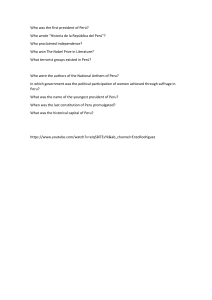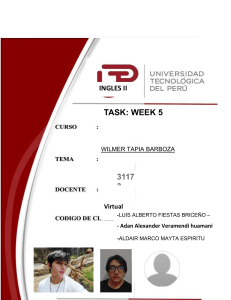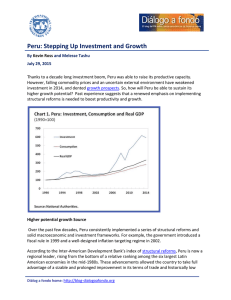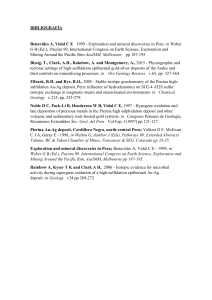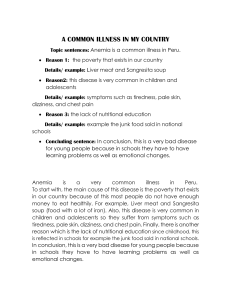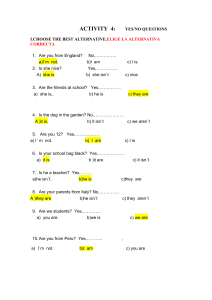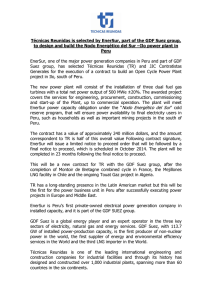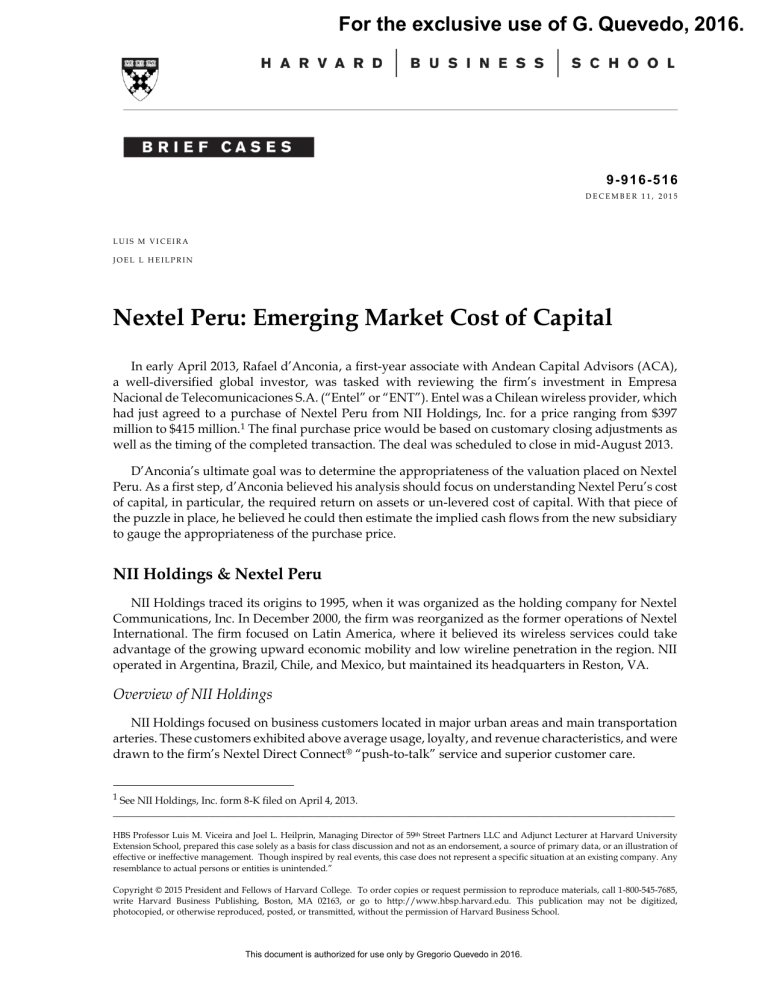
For the exclusive use of G. Quevedo, 2016. 9 -9 1 6 -5 1 6 DECEMBER 11, 2015 LUIS M VICEIRA JOEL L HEILPRIN Nextel Peru: Emerging Market Cost of Capital In early April 2013, Rafael d’Anconia, a first-year associate with Andean Capital Advisors (ACA), a well-diversified global investor, was tasked with reviewing the firm’s investment in Empresa Nacional de Telecomunicaciones S.A. (“Entel” or “ENT”). Entel was a Chilean wireless provider, which had just agreed to a purchase of Nextel Peru from NII Holdings, Inc. for a price ranging from $397 million to $415 million.1 The final purchase price would be based on customary closing adjustments as well as the timing of the completed transaction. The deal was scheduled to close in mid-August 2013. D’Anconia’s ultimate goal was to determine the appropriateness of the valuation placed on Nextel Peru. As a first step, d’Anconia believed his analysis should focus on understanding Nextel Peru’s cost of capital, in particular, the required return on assets or un-levered cost of capital. With that piece of the puzzle in place, he believed he could then estimate the implied cash flows from the new subsidiary to gauge the appropriateness of the purchase price. NII Holdings & Nextel Peru NII Holdings traced its origins to 1995, when it was organized as the holding company for Nextel Communications, Inc. In December 2000, the firm was reorganized as the former operations of Nextel International. The firm focused on Latin America, where it believed its wireless services could take advantage of the growing upward economic mobility and low wireline penetration in the region. NII operated in Argentina, Brazil, Chile, and Mexico, but maintained its headquarters in Reston, VA. Overview of NII Holdings NII Holdings focused on business customers located in major urban areas and main transportation arteries. These customers exhibited above average usage, loyalty, and revenue characteristics, and were drawn to the firm’s Nextel Direct Connect® “push-to-talk” service and superior customer care. 1 See NII Holdings, Inc. form 8-K filed on April 4, 2013. ________________________________________________________________________________________________________________ HBS Professor Luis M. Viceira and Joel L. Heilprin, Managing Director of 59th Street Partners LLC and Adjunct Lecturer at Harvard University Extension School, prepared this case solely as a basis for class discussion and not as an endorsement, a source of primary data, or an illustration of effective or ineffective management. Though inspired by real events, this case does not represent a specific situation at an existing company. Any resemblance to actual persons or entities is unintended.” Copyright © 2015 President and Fellows of Harvard College. To order copies or request permission to reproduce materials, call 1-800-545-7685, write Harvard Business Publishing, Boston, MA 02163, or go to http://www.hbsp.harvard.edu. This publication may not be digitized, photocopied, or otherwise reproduced, posted, or transmitted, without the permission of Harvard Business School. This document is authorized for use only by Gregorio Quevedo in 2016. For the exclusive use of G. Quevedo, 2016. 916-516 | Nextel Peru: Emerging Market Cost of Capital NII’s network was originally rolled out on 800 MHz spectrum that was often non-contiguous. To overcome some of these limitations and support the company’s flagship Direct Connect offerings, NII utilized the iDEN2 platform developed by Motorola. iDEN was the only widely available commercial technology capable of utilizing non-contiguous spectrum, but it had drawbacks. First, the 800 MHz spectrum owned by NII was less well suited for advanced 3G and 4G networks. While the longer wavelength of the spectrum covered a larger geographic area, the longer cycle time of the frequency also meant less data capacity for advanced cellular services. Second, Motorola was the sole supplier of the technology. NII thus depended on Motorola not only to continue supporting and developing the technology, but also to continue providing new handset models. When Sprint Nextel, which was the largest purchaser of iDEN technology, decided to decommission its iDEN network, Motorola was no longer willing to commit its support for the technology. Agreements to support the iDEN network infrastructure and provide compatible handsets ran only through the end of 2014. The phasing out of iDEN, along with the wireless industry’s evolution toward third and fourthgeneration services based on wideband code division multiple access (WCDMA) technology that used spectrum in the 1.7 GHz – 2.1 GHz range, forced NII to play catch-up. The company’s large investments in spectrum and network reconfiguration increased its operating costs. It subsequently launched its first WCDMA network in Peru in 2010, and began similar launches for Brazil, Chile, and Mexico in 2012.3 Despite these investments, competition decreased the firm’s operating performance relative to its peers. (Exhibit 1 shows the results for comparable wireless firms in the region.) In each of its markets, NII competed with at least two larger rivals with more financial resources, larger networks and distribution channels, and significant scale advantages. Those circumstances, along with a desire to enhance liquidity, contributed to the firm’s decision to concentrate its efforts on its core markets in Brazil and Mexico while considering strategic alternatives for Argentina, Chile, and Peru. NII Operating Performance As competition in the Latin American wireless market intensified, leading providers such as Telefonica SA and America Movil targeted NII’s higher-paying corporate clients by leveraging their larger faster networks and attracting customers with unlimited calls. Many analysts felt that NII’s technology was outdated. The region’s increasingly sophisticated customers had moved past push-totalk, and were demanding smart phones on mobile data networks, which offered a number of instant messaging alternatives. The competitive pressures had affected the company’s financial results. NII had budgeted $1.5 billion to build out its new network and subsidize handsets, but its total revenue had decreased from $6.7 billion in 2011 to $6.1 billion in 2012, and service revenue had fallen from $6.4 billion to $5.8 billion. NII’s bottom line had swung from a profit of $225.2 million to a loss of $765.2 million, and its stock price had decreased 65% over the year. (Exhibit 2 shows the company’s actual and pro forma results). In a press release on November 6, 2012, NII announced that it would reduce the headcount at its headquarters by 20%.4 The falling revenue and profits had also prompted concern among the analyst community. Christina Ronac of Gleacher & Co. expressed concern that NII could burn through most 2 iDEN is an integrated digital enhanced network developed by Motorola based on time division multiple access technology, which focuses on the use of discontinuous GSM spectrum. 3 In September 2012, the Argentine government canceled its auction of PCS and 850 band spectrum. As a result, Nextel Argentina does not have access to spectrum that would support a WCDMA network. 4 Company press release, November 6, 2012, http://phx.corporate-ir.net/phoenix.zhtml?c=137178&p=irolnewsArticle&ID=1754868&highlight=. Accessed on 4/14/14. 2 BRIEFCASES | HARVARD BUSINESS SCHOOL This document is authorized for use only by Gregorio Quevedo in 2016. For the exclusive use of G. Quevedo, 2016. Nextel Peru: Emerging Market Cost of Capital | 916-516 of its $2.0 billion of cash by the end of 2013.5 Similarly, Carlos Sequeria of BTG Pactual Group worried that the company’s net debt could surpass 4.0x EBITDA over the next 12 months. 6 To ameliorate some of the liquidity pressure, NII announced it would refocus its operations on Brazil and Mexico and pursue strategic options for its operations in Argentina, Chile, and Peru.7 In conjunction with the strategic shift, the firm announced a $300 million non-cash impairment charge related to its Chilean operations. Overview of Nextel Peru The Peruvian operations were similar to those of NII as a whole. Nextel Peru was focused on business and high value customers in major urban areas that were attracted to its push-to-talk feature, and its superior customer care. The company operated in a market dominated by much larger rivals with significantly more resources, Telefonica of Spain and Claro, a unit of America Movil. Likewise, it faced the same technological dilemmas. Nextel Peru had significant nationwide holdings of 800 MHz spectrum. However, because the spectrum was largely non-contiguous, or only partially contiguous, its usefulness for CDMA, WCDMA, or other cellular technologies beyond iDEN was limited. 8 To make use of the spectrum, its band would have needed to be reconfigured, which would have required regulatory support. From a financial perspective, Nextel Peru accounted for 6% of NII’s operating revenue and 15% of the firm’s subscriber base during 2012. (Exhibit 2 provides consolidated operating data and Exhibit 3 provides operating data for Nextel Peru) 9 Prior to the launch of Nextel Peru’s WCDMA network in 2010, the firm had just over a million subscribers, which NII doubled by the end of 2012. (Exhibit 4 provides subscriber data for NII Holdings and Nextel Peru). However, much of this growth was due to promotional data card plans, which negatively affected the average revenue per user (ARPU). Even though the firm began operating its new network in 2010, it did not begin Direct Connect until September 2011. In addition to the drop in ARPU, the transition to 3G forced the company to simultaneously support its legacy iDEN network along with the new WCDMA network. This resulted in an 8% increase in the cost of services, and a 14% increase in selling and marketing expenses. In turn, these factors lead to a 14% drop in the 2012 EBITDA margin. Long-Term Prospects for Nextel Peru As d’Anconia contemplated Nextel Peru’s recent results and competitive position, he believed that the firm’s current problems would largely be ameliorated in the hands of a larger firm with strong operations such as Entel. As a result, he believed Nextel Peru’s long-term prospects would mirror those of other firms in the industry, and be driven by the Peruvian economy. Peru’s economy was among the fastest growing in Latin America, while its rate of inflation was among the lowest in the region, averaging approximately 2.78% over the past ten years. During 2012, GDP grew 6.3% on top of 7.0% growth for 2011.10 In contrast, ACA estimated a long-term growth rate for the United States of only 3.0%. Further, the Peru’s central bank predicted annual economic growth 5 Parra-Bernal, Guillermo and Haynes, Brad, “Analysis: Nextel’s NII Faces Uphill Battle in Brazil”, Reuters, November 7, 2012. 6 Parra-Bernal, Guillermo and Haynes, Brad, “Analysis: Nextel’s NII Faces Uphill Battle in Brazil”, Reuters, November 7, 2012. 7 Company press release February 5, 2013, http://phx.corporate-ir.net/phoenix.zhtml?c=137178&p=irol- newsArticle&ID=1781387&highlight=. Accessed on 4/4/14. 8 The 800MHz SMR band was used exclusively for iDEN however, in the US, Sprint is deploying CDMA and LTE technology on the band. Also, on September 2, 2011, the FCC approved the SMR band for several CDMA devices. 9 Nextel Peru’s operating and reporting currency is the US dollar. 10 http://www.focus-economics.com/country-indicator/peru/gdp. HARVARD BUSINESS SCHOOL | BRIEFCASES This document is authorized for use only by Gregorio Quevedo in 2016. 3 For the exclusive use of G. Quevedo, 2016. 916-516 | Nextel Peru: Emerging Market Cost of Capital for 2013 and 2014 to be between 6.0% and 6.5%. On the other hand, the most recent quarterly data were a mixed bag. A slowdown in domestic demand during the fourth quarter led to growth of 5.9%, below consensus expectations of 6.3%. Gross fixed investment had slowed to 11.3% from 17.1% in the previous quarter. However, Peru’s trade balance had improved somewhat export growth increased from 1.1% to 1.2%, and the growth of imports decreased from 15.2% to 9.9%. Overall, the external sector improved from a -3.3% contribution to GDP to a -2.0% contribution. Exhibit 5 shows the long-term trends in Peru’s real per capita GDP and CPI. The Cost of Capital To determine the required rate of return, d’Anconia began by employing a framework based on the portfolio improvement rule; and in turn, the Capital Asset Pricing Model (CAPM), as shown below. 𝑅𝑒𝑞𝑢𝑖𝑟𝑒𝑑 𝑅𝑎𝑡𝑒 𝑜𝑓 𝑅𝑒𝑡𝑢𝑟𝑛 = 𝑟𝑓 + 𝛽(𝑀𝑎𝑟𝑘𝑒𝑡 𝑅𝑖𝑠𝑘 𝑃𝑟𝑒𝑚𝑖𝑢𝑚) In CAPM, the term rf denotes the risk-free rate, β is a measure of systematic risk, and the market risk premium is the amount by which the return on a broadly diversified portfolio of risky assets is expected to exceed the risk-free return over a specific investment horizon. In considering the CAPM, d’Anconia also needed to consider whether his analysis should be based on the local market, global market, broader emerging market, or U.S. market data. In addition to the portfolio improvement rule, d’Anconia had observed that practitioners often modified the CAPM to include estimates of country risk premium for investments made in less developed markets. The logic employed for these premiums was based on various considerations, including: the lack of political stability, market liquidity, sovereign credit risk, size of the economy, and size of the middle class among others. Moreover, a number of these practitioner rules, such as those promulgated by Damodaran, Lessard, Godfrey-Espinosa, and Goldman Sachs, appeared to have significant following.11 Finally, there was the matter of how, if at all, differences in expected inflation might figure into required return estimates. D’Anconia believed inflation in the United States and other major developed economies would be approximately 2.0% versus Peru’s 2.78%. Practitioner Use of Country Risk Premiums With respect to the country risk premium and its incorporation into the required rate of return, d’Anconia considered several approaches, each having varying degrees of market acceptance. As a starting point, he looked at the spread between local government bonds and U.S. treasury bonds. (Exhibit 6 in the Student Spreadsheet, HBS No. 916-518, contains these returns).12 According to some proponents, the upside to this approach was its simplicity, and the fact that the difference in bond spreads incorporated many of the same macroeconomic factors that affect equities such as inflation, trade balances, budget deficits, and political stability. The downside was that the spread between country bond yields measured primarily relative default risk. D’Anconia realized that if he were to employ a country risk premium, perhaps the equity risk should also be considered. As an alternative, d’Anconia also considered adjusting the U.S. equity market risk premium to reflect the relative volatility of Peruvian equities vis-à-vis their U.S. counterparts. The logic was that 11 See Damodaran, Aswath, “Security Analysis for Investment and Corporate Finance”, 2nd Edition, John Wiley & Sons, 2006. Lessard, D. R., “Incorporating Country Risk in the Valuation of Offshore Projects”, Journal of Applied Corporate Finance, Vol. 9, 1996. Godfrey, S. and Espinosa, R., “A Practical Approach to Calculating the Cost of Equity for Investment in Emerging Markets”, Journal of Applied Corporate Finance”, Fall 1996. 12 Country bond spreads can have significant volatility. In practice, this can be mitigated by averaging the spread over time. 4 BRIEFCASES | HARVARD BUSINESS SCHOOL This document is authorized for use only by Gregorio Quevedo in 2016. For the exclusive use of G. Quevedo, 2016. Nextel Peru: Emerging Market Cost of Capital | 916-516 the standard deviation of emerging market equity returns should reflect their increased risk. The method d’Anconia was considering is laid out below.13 (Exhibit 6 in the Student Spreadsheet, HBS No. 916-518, contains Peruvian and U.S. stock market returns.) 𝑅𝑒𝑙𝑎𝑡𝑖𝑣𝑒 𝜎𝐶𝑜𝑢𝑛𝑡𝑟𝑦 𝑋 = 𝜎𝐶𝑜𝑢𝑛𝑡𝑟𝑦 𝑋 𝜎𝑈𝑆 The adjusted equity market risk premium would be determined as shown below. The country risk premium would be the difference between the U.S. market risk premium and the local market risk premium. 𝐴𝑑𝑗𝑢𝑠𝑡𝑒𝑑 𝐸𝑞𝑢𝑖𝑡𝑦 𝑀𝑎𝑟𝑘𝑒𝑡 𝑅𝑖𝑠𝑘 𝑃𝑟𝑒𝑚𝑖𝑢𝑚 = (𝐸𝑀𝑅𝑃𝑈𝑆 )(𝑅𝑒𝑙𝑎𝑡𝑖𝑣𝑒 𝜎𝐶𝑜𝑢𝑛𝑡𝑟𝑦 𝑋 ) The final method d’Anconia considered for determining country risk premium involved multiplying the country default spread by the relative standard deviation of Peruvian equities versus Peruvian long-term government bonds.14 The logic behind this approach was straightforward. Equities carried more risk than sovereign bonds did, and this incremental risk was reflected by the relative standard deviations. The equation below illustrates d’Anconia’s approach. 𝐶𝑜𝑢𝑛𝑡𝑟𝑦 𝑅𝑖𝑠𝑘 𝑃𝑟𝑒𝑚𝑖𝑢𝑚 = (𝐶𝑜𝑢𝑛𝑡𝑟𝑦 𝐷𝑒𝑓𝑎𝑢𝑙𝑡 𝑆𝑝𝑟𝑒𝑎𝑑) ( 𝜎𝐸𝑞𝑢𝑖𝑡𝑦_𝐶𝑜𝑢𝑛𝑡𝑟𝑦 𝑋 ) 𝜎𝐷𝑒𝑏𝑡_𝐶𝑜𝑢𝑛𝑡𝑟𝑦 𝑋 The country risk premium would then be added to the U.S. equity market risk premium to arrive at an equity market risk premium for Peru. Integrating Country Risk Premium into the Cost of Capital D’Anconia realized if he were to employ a separate country risk premium, he would also have to incorporate it within CAPM. Again, practitioners used numerous methods for integrating the country risk premium into the cost of capital determination. The first method was to add the country risk premium to the CAPM as follows. 𝑅𝑒𝑞𝑢𝑖𝑟𝑒𝑑 𝑅𝑎𝑡𝑒 𝑜𝑓 𝑅𝑒𝑡𝑢𝑟𝑛 = 𝑟𝑓 + 𝛽(𝐸𝑀𝑅𝑃𝑈𝑆 ) + 𝐶𝑜𝑢𝑛𝑡𝑟𝑦 𝑅𝑖𝑠𝑘 𝑃𝑟𝑒𝑚𝑖𝑢𝑚 Although this approach was widely used, d’Anconia had some reservations about it because it implied that all companies had the same country risk exposure. As an alternative, he noticed that many professionals scaled the country risk premium by the company’s level of systematic risk exposure as shown below. 𝑅𝑒𝑞𝑢𝑖𝑟𝑒𝑑 𝑅𝑎𝑡𝑒 𝑜𝑓 𝑅𝑒𝑡𝑢𝑟𝑛 = 𝑟𝑓 + 𝛽(𝐸𝑀𝑅𝑃𝑈𝑆 + 𝐶𝑜𝑢𝑛𝑡𝑟𝑦 𝑅𝑖𝑠𝑘 𝑃𝑟𝑒𝑚𝑖𝑢𝑚) So long as Nextel Peru’s country risk exposure approximated its exposure to all other macroeconomic risks, professionals felt this approach would be satisfactory. However, there was the possibility that country risk might be different from other types of risk, and could therefore be scaled separately by its own factor, λ in the following identity. 𝑅𝑒𝑞𝑢𝑖𝑟𝑒𝑑 𝑅𝑎𝑡𝑒 𝑜𝑓 𝑅𝑒𝑡𝑢𝑟𝑛 = 𝑟𝑓 + 𝛽(𝐸𝑀𝑅𝑃𝑈𝑆 ) + 𝜆(𝐶𝑜𝑢𝑛𝑡𝑟𝑦 𝑅𝑖𝑠𝑘 𝑃𝑟𝑒𝑚𝑖𝑢𝑚) If d’Anconia were to go this route, he thought the ratio of Nextel Peru’s domestic revenue relative to the average percentage of domestic revenues earned by Peruvian firms generally. He assumed that 13 Damodaran, Aswath, “Damodaran on Valuation: Security Analysis for Investment and Corporate Finance, 2nd Edition, John Wiley & Sons, 2006, pg. 42-44. 14 Damodaran, Aswath, “Damodaran on Valuation: Security Analysis for Investment and Corporate Finance, 2nd Edition, John Wiley & Sons, 2006, pg. 44-45. HARVARD BUSINESS SCHOOL | BRIEFCASES This document is authorized for use only by Gregorio Quevedo in 2016. 5 For the exclusive use of G. Quevedo, 2016. 916-516 | Nextel Peru: Emerging Market Cost of Capital Nextel Peru earned 100% of its revenues domestically, while the average Peruvian firm derived 75% of its revenue locally. As d’Anconia sized up the tasks at hand, he considered his objectives. Ultimately, he wanted to understand whether the $400 million purchase price for Nextel Peru was reasonable. Further, he believed that the valuation would be driven primarily by the timing, growth, and riskiness of expected cash flows. To simplify the exercise, he wanted to employ ACA’s assumption for the market risk premium, which was 5.0%. However, he was uncertain if this assumption was appropriate for Peru. He knew that a number of analysts were using a 7.0% risk premium for Latin America. As a final simplification, d’Anconia decided to treat the Peruvian wireless market as mature, and then estimate the expected cash flows as the function of a growing perpetuity. Ultimately, d’Anconia’s immediate concern was the cost of capital. He felt that once this was determined, the rest of the analysis would fall into place. In turn, this meant he needed to decide on an appropriate methodology. On the one hand, there was the portfolio improvement rule, which d’Anconia recalled from his days in school as the foundation of CAPM. On the other hand, there were the various practitioners’ methodologies to consider. 6 BRIEFCASES | HARVARD BUSINESS SCHOOL This document is authorized for use only by Gregorio Quevedo in 2016. Net Debt 363,978 2,238 385,754 3,774 28,921 (3,969) 975 2,213 1,632 This document is authorized for use only by Gregorio Quevedo in 2016. 1 EBIAT = EBIT(1-t) using the effective tax rate. 2 5 year revenue growth is on a compound annual basis. Source: Data from S&P Capital IQ, accessed 2/27/13. Average Median Companies: America Movil Embratel Participacoes S.A. Empresa Nacional De Telecomunicaciones NII Holdings Oi SA Telecom Argentina Telefonica Brasil Telefonica Del Peru TIM Participacoes S.A. (Local Currency in Millions) 7 Case writer estimates 3 Source: Bloomberg, accessed 3/14/14. Raw three year 4 Source: Bloomberg, accessed 3/14/14. Raw three year 5 Source: Bloomberg, accessed 3/14/14. Raw three year 6 Source: Bloomberg, accessed 3/14/14. Raw three year Minority Interest 8,990 4,842 0 0 0 200 0 0 0 Enterprise Value 1,336,850 20,252 2,742,713 4,716 39,073 20,398 60,957 10,045 22,828 28.7% 13.0% Revenue Growth 13.0% 45.0% 14.8% -11.7% 165.1% 18.3% 2.1% 5.3% 6.8% 15.5% 18.3% 29.7% 30.1% 12.5% 12.1% Last 12 Months: EBIT EBITDA EBIAT Margin Margin Margin1 19.7% 33.0% 21.8% 11.5% 26.9% 5.9% 17.4% 38.4% 14.5% 0.9% 14.2% NM 18.6% 30.1% 12.3% 18.3% 26.3% 11.9% 20.2% 35.9% 12.8% 19.3% 34.7% 11.3% 13.8% 28.0% 9.5% monthly betas based on local currencies. monthly betas based on U.S. dollar denominated returns. monthly betas based on U.S. dollar denominated returns. monthly betas. 1 Stock prices as of 4/1/13, except NII Holdings, which was 4/5/13. 2 Quarterly average over the past three years. Source: All information except equity betas S&P Capital IQ, accessed 3/14/14. Companies: America Movil Embratel Participacoes S.A. Empresa Nacional De Telecomunicaciones NII Holdings Oi SA Telecom Argentina Telefonica Brasil Telefonica Del Peru TIM Participacoes S.A. Equity Value1 963,882 13,173 2,356,959 943 10,152 24,167 59,983 7,833 21,196 Comparable Latin American Wireless Companies (Local Currency in Millions) Exhibit 1 4.6% 3.0% FCF Margin 10.6% -11.0% 3.0% -6.7% 2.4% 8.5% 19.2% 12.8% 2.3% Current D/V 27.23% 11.05% 14.06% 80.01% 74.02% -19.46% 1.60% 22.03% 7.15% 14.2% 17.2% Revenue Growth2 19.1% 17.2% 8.1% 10.4% 20.5% 19.4% 18.1% 6.3% 8.6% Historic D/V2 17.73% 25.18% 13.74% 41.68% 32.48% -13.91% 3.28% 26.57% 6.78% MSCI World Equity Beta4 1.01 0.63 0.80 0.77 1.14 1.17 1.58 0.35 0.81 MSCI Latin Equity Beta5 0.75 0.64 0.81 0.67 1.08 0.89 0.63 0.24 0.74 16.9% 19.2% 29.1% 30.5% 11.9% 10.9% 5 Year Average: EBIT EBITDA EBIAT Margin Margin Margin1 12.0% 14.4% 10.3% 12.1% 13.1% 8.6% 21.6% 42.7% 18.2% 14.0% 24.2% 9.1% 22.2% 33.9% 15.9% 20.8% 30.5% 13.5% 21.4% 36.9% 15.0% 19.2% 39.7% 10.9% 8.6% 26.6% 5.2% S&P Equity Beta3 1.12 0.53 0.83 0.65 1.08 1.31 0.73 0.38 0.82 9.5% 11.1% FCF Margin 11.1% 1.3% 5.6% 3.0% 16.0% 12.1% 16.9% 15.7% 4.2% Local Equity Beta6 0.91 0.56 0.77 0.65 0.86 1.05 0.47 0.49 0.58 Debt Beta7 0.12 0.05 0.07 0.18 0.15 0.00 0.00 0.17 0.07 916-516 -7- For the exclusive use of G. Quevedo, 2016. For the exclusive use of G. Quevedo, 2016. 916-516 | Nextel Peru: Emerging Market Cost of Capital Exhibit 2 NII Holdings Historical Financial Data Historical Consolidated Income Statements for NII ($000's) Operating Results: Service Revenue Plus: Handset & Accessory Revenue Total Operating Revenue Less: Cost of Service (Excluding Depreciation & Amortization) Less: Cost of Handset Sales Gross Profit Less: Selling & Marketing1 EBITDA Less: Depreciation & Amortization Operating Income Less: Interest Expense Plus: Interest Income Plus: Foreign Currency Gains Less: Other Expenses Earnings Before Taxes Less: Taxes Net Income 2010 5,348,400 257,407 5,605,807 1,504,603 719,219 3,381,985 1,946,706 1,435,279 554,886 880,393 344,999 28,841 52,374 18,686 597,923 259,465 338,458 2011 6,403,519 331,427 6,734,946 1,789,402 855,929 4,089,615 2,504,976 1,584,639 653,087 931,552 322,111 34,224 (36,975) 37,305 569,385 344,189 225,196 2012 5,779,159 307,304 6,086,463 1,690,464 915,120 3,480,879 2,875,359 605,520 728,780 (123,260) 373,253 34,143 (53,415) 27,355 (543,140) 222,109 (765,249) Assets: Cash & Cash Equivalents Plus: Short-Term Investments Plus: Net Accounts Receivable Plus: Handset Inventory Plus: Deferred Taxes Plus: Prepaid Expenses & Other Current Assets Total Current Assets 2010 1,767,501 537,539 788,000 227,191 186,988 393,658 3,900,877 2011 2,322,919 343,422 858,471 277,291 203,012 331,407 4,336,522 2012 1,383,491 204,834 705,737 349,704 175,753 515,513 3,335,032 Net Property, Plant & Equipment Plus: Net Intangible Assets Plus: Deferred Taxes Plus: Other Assets Total Assets 2,960,046 433,208 486,098 410,458 8,190,687 3,481,869 1,182,380 410,162 411,203 9,822,136 3,884,947 1,164,672 367,182 471,245 9,223,078 Liabilities & Owners' Equity: Accounts Payable Plus: Accrued & Other Expenses Plus: Deferred Revenue Plus: Current Portion of Long-Term Debt Total Curent Liabilities 300,030 827,253 158,690 446,995 1,732,968 377,679 1,008,932 159,150 573,465 2,119,226 485,542 1,015,788 161,451 97,244 1,760,025 Long-Term Debt Plus: Deferred Revenue Plus: Deferred Tax Liabilities Plus: Other Long-Term Liabilities Total Liabilities 2,818,423 20,476 88,068 211,179 4,871,114 4,244,752 15,585 61,156 243,335 6,684,054 4,768,958 14,007 58,189 305,450 6,906,629 Total Stockholders' Equity Total Liabilities & Stockholders' Equity 3,319,573 8,190,687 3,138,082 9,822,136 2,316,449 9,223,078 Historical Consolidated Balance Sheets for NII ($000's) Source: Company annual 10-Ks. 8 BRIEFCASES | HARVARD BUSINESS SCHOOL This document is authorized for use only by Gregorio Quevedo in 2016. For the exclusive use of G. Quevedo, 2016. Nextel Peru: Emerging Market Cost of Capital | 916-516 Exhibit 2A NII Holdings Historical Pro Forma Financial Data Historical Pro Forma Consolidated Income Statements for NII ($000's) Operating Results: Service Revenue Plus: Handset & Accessory Revenue Total Operating Revenue Less: Cost of Service (Excluding Depreciation & Amortization) Less: Cost of Handset Sales Gross Profit Less: Selling & Marketing1 EBITDA Less: Depreciation & Amortization Operating Income Less: Interest Expense Plus: Interest Income Plus: Foreign Currency Gains Less: Other Expenses Earnings Before Taxes Less: Taxes Net Income 2010 5,066,404 227,387 5,293,791 1,404,555 656,409 3,232,827 1,813,607 1,419,220 502,203 917,017 335,918 28,334 52,412 18,686 643,159 269,869 373,290 2011 6,081,577 299,240 6,380,817 1,681,692 784,072 3,915,053 2,360,303 1,554,750 588,164 966,586 311,735 34,096 (37,297) 37,750 613,900 351,204 262,696 2012 5,465,120 278,002 5,743,122 1,574,327 829,859 3,338,936 2,714,770 624,166 649,545 (25,379) 365,521 33,862 (53,957) 28,340 (439,335) 158,141 (597,476) Source: NII Holdings 8-K filed 8/19/2013. 1 Includes doubtful accounts $73,497, $159,202, and $217,315 for the years 2010, 2011, and 2012 respectively. 2012 also includes a $329,767 impairment charge Exhibit 3 Nextel Peru Historical Financial Data Historical Operating Results ($000's) Operating Results1: Service Revenue Plus: Handset Revenue Total Operating Revenue Less: Cost of Services2 Less: Cost of Handset Sales Gross Profit Less: Selling & Marketing Expenses3 Less: General & Administrative Expenses Segment EBITDA 2010 281,995 30,021 312,016 100,048 62,810 149,158 55,783 71,112 22,263 2011 321,942 32,187 354,129 107,710 71,857 174,562 63,575 75,672 35,315 2012 314,039 29,302 343,341 116,137 85,261 141,943 72,375 83,549 (13,981) Estimated Depreciation4 Total Assets Capital Expenditures 34,137 556,752 94,000 35,858 597,891 105,500 35,088 498,230 77,700 59,863 69,642 42,612 Net Reinvestment in Long-Term Assets 1 2 3 4 Source: Company 10-K's for the years 2010-2012. Excludes depreciation and amortization. For 2012, the figure includes $3.28 million of doubtful accounts. Case writer estimate based on proportion of segment assets to total consolidated assets. HARVARD BUSINESS SCHOOL | BRIEFCASES This document is authorized for use only by Gregorio Quevedo in 2016. 9 For the exclusive use of G. Quevedo, 2016. 916-516 | Nextel Peru: Emerging Market Cost of Capital Exhibit 4 NII Holdings and Nextel Peru Historical Subscriber Data NII Holdings Subscriber Data: Total Handsets in Use Net Sbscriber Increase Estimated Average Subscribers Growth in Subscribers ARPU1 2010 9,027 1,685 8,816 21.0% 607 2011 10,712 650 10,491 19.0% 610 2012 11,362 629 11,121 6.0% 520 Nextel Peru Subscriber Data: Total Handsets in Use Net Sbscriber Increase Estimated Average Subscribers Growth in Subscribers ARPU1 1,128 286 985 34.0% 286 1,435 307 1,282 27.2% 251 1,660 225 1,548 15.7% 203 Source: Company 10-Ks 1 Calculated as service revenue divided by estimated average subscribers. 10 BRIEFCASES | HARVARD BUSINESS SCHOOL This document is authorized for use only by Gregorio Quevedo in 2016. For the exclusive use of G. Quevedo, 2016. Nextel Peru: Emerging Market Cost of Capital | 916-516 Exhibit 5 Peruvian Economic Data Peruvian CPI 120.00 110.00 100.00 90.00 80.00 70.00 60.00 50.00 40.00 30.00 20.00 01-Dec-2012 01-Apr-2012 01-Aug-2012 01-Dec-2011 01-Apr-2011 01-Aug-2011 01-Dec-2010 01-Apr-2010 01-Aug-2010 01-Dec-2009 01-Apr-2009 01-Aug-2009 01-Dec-2008 01-Apr-2008 01-Aug-2008 01-Dec-2007 01-Apr-2007 01-Aug-2007 01-Dec-2006 01-Apr-2006 01-Aug-2006 01-Dec-2005 01-Apr-2005 01-Aug-2005 01-Dec-2004 01-Apr-2004 01-Aug-2004 01-Dec-2003 01-Apr-2003 0.00 01-Aug-2003 10.00 Source: FactSet Economics, accessed 6/19/14 Peruvian Real GDP Per Capita 7,000 6,000 5,000 4,000 3,000 2,000 1,000 0 1994 1995 1996 1997 1998 1999 2000 2001 2002 2003 2004 2005 2006 2007 2008 2009 2010 2011 2012 Source: FactSet Economics, accessed 6/19/14. HARVARD BUSINESS SCHOOL | BRIEFCASES This document is authorized for use only by Gregorio Quevedo in 2016. 11
